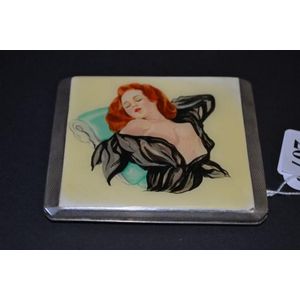Manganese Delftware Tile: Man and Beer Barrels
You must be a subscriber, and be logged in to view price and dealer details.
Subscribe Now to view actual auction price for this item
When you subscribe, you have the option of setting the currency in which to display prices to $Au, $US, $NZ or Stg.
- Manganese Glaze - A manganese glaze contains manganese dioxide as a colorant. When fired at high temperatures, the manganese dioxide in the glaze reacts with the clay body to create a range of colors, including brown, black, purple, and deep red.
Manganese glazes have been used to decorate ceramics for thousands of years, and they have been particularly popular in Chinese and Korean pottery. In China, manganese glazes were first used during the Song dynasty (960-1279 AD), and they were later used in the production of Jun ware during the Ming dynasty (1368-1644 AD). In Korea, manganese glazes were used to decorate celadon pottery during the Goryeo dynasty (918-1392 AD).
The glaze can be applied to pottery using a variety of techniques, including brushing, pouring, and spraying. The glaze can be applied alone or in combination with other glazes to create a range of effects, including speckled or mottled surfaces. However these glazes can be difficult to control, as they tend to be very fluid and can easily run or drip during firing. However, this fluidity can also be used to create interesting effects, such as the "hare's fur" pattern that is often seen in Chinese tea bowls.
Manganese glazes are still in use by potters and ceramic artists to create unique and beautiful surfaces on their work. - Earthenware - A basic ceramic material that is fired at a low temperature. Earthenware is the basis of almost all ancient, medieval, Middle Eastern and European painted ceramics. After firing, the colour is the colour of the clay when it is dug from the ground: buff, brown and red. It is not waterproof until glazed. Creamware is a type of earthenware covered with a transparent lead glaze. Majolica, faience and delft are also earthenware covered in an opaque white tin glaze.
This item has been included into following indexes:
Visually similar items

Tile, English c.1760, in delftware, decorated with a painting in manganese, depicting Mose and the Burning Bush (Ex. 3:1-22)

Map, Insulae Indaie Orientalis in Quibus Moluccae Celeberrimae Sunt. Mapmaker Hondius, pub. Amsterdam 1613. Hand coloured engraving. 35 x 4 8 cm

Sterling silver cigarette box with enamelled 'Glamour Girl' top, Birmingham 1931

Three Chinese Porcelain Plaques, Qing Dynasty, finely painted with the Queen Mother of the West wearing an iron red robe, gliding through the clouds, gilt highlights [3]
